
1. TITLE PAGE
1.1 INTRODUCTION..........................................................................................................2
1.2 REVISION HISTORY ..................................................................................................2
1.3 UNDERSTANDING THIS MANUAL .............................................................................2
1.4 COPYRIGHT NOTICE .................................................................................................2
2. CONTENTS
2.1 CONTENTS.................................................................................................................. 3
3. INTRODUCTION
3.1 SCOPE.........................................................................................................................4
3.2 SPECIFICATION ..........................................................................................................4
3.3 HANDLING AND STORAGE........................................................................................ 4
4. HEALTH AND SAFETY INFORMATION
4.1 WARNING .................................................................................................................... 5
5. TECHNICAL DESCRIPTION
5.1 IDENTIFICATION ......................................................................................................... 6
6. UNPACKING AND CHECKING
6.1 PACKAGING ................................................................................................................7
7. INSTRUCTIONS FOR USE
7.1 REASONS FOR ACCIDENTS...................................................................................... 8
7.2 BEFORE USE ..............................................................................................................9
7.3 POSITIONING AND ERECTING THE LADDER ..........................................................9
7.4 USING THE LADDER ................................................................................................10
7.5 OPERATION .............................................................................................................. 11
8. CARE & MAINTENANCE
8.1 INSPECTION .............................................................................................................12
8.2 STORAGE.................................................................................................................. 13
9. EXPLANATION OF SYMBOLS .............................................................................................. 14
10. DISPOSAL
10.1 DISPOSAL .................................................................................................................15
DECLARATION OF CONFORMITY .............................................................................. ENCLOSED
1.1 INTRODUCTION:
USER MANUAL FOR: FIBREGLASS STEP LADDERS
Stock No’s: 90409, 90417, 90420.
Part No’s: FGL3A, FGL5A, FGL7A.
As our user manuals are continually updated, users should make sure that they use
the very latest version.
Downloads are available from: http://drapertools.com/manuals
Draper Tools Limited
Hursley Road
Chandler’s Ford
Eastleigh
Hampshire
SO53 1YF
UK
Website: drapertools.com
Product Helpline: +44 (0) 23 8049 4344
General Fax: +44 (0) 23 8026 0784
1.3 UNDERSTANDING THIS MANUALS SAFETY CONTENT:
WARNING! – Information that draws attention to the risk of injury or death.
CAUTION! – Information that draws attention to the risk of damage to the product or
surroundings.
1.4 COPYRIGHT © NOTICE:
Copyright © Draper Tools Limited.
Permission is granted to reproduce this publication for personal and educational use
only. Commercial copying, redistribution, hiring or lending is prohibited.
No part of this publication may be stored in a retrieval system or transmitted in any
other form or means without written permission from Draper Tools Limited.
In all cases this copyright notice must remain intact.
1.2 REVISIONS:
3.1 SCOPE
This ladder is an A-frame step ladder of between 3-7 rungs plus a plastic top cap. It is used to
allow safe temporary access to areas outside the normal reach of the user.
Any application other than that it was intended for, is considered misuse.
3.2 SPECIFICATION
Stock No..........................................90409 ................................... 90417..................................... 90420
Part No. .......................................... FGL3A ..................................FGL5A ...................................FGL7A
Number of rungs................................ 3 ..........................................5 ............................................... 7
Closed height ................................. 1.2m .................................... 1.8m ...................................... 2.4m
Open height................................... 1.06m ................................. 1.615m .................................. 2.17m
Spread.......................................... 0.881m ................................ 1.275m ................................ 1.669m
Max. standing height ..................... 0.26m .................................. 0.82m ................................... 1.38m
Weight ............................................6.1kg.....................................8.kg.....................................11.6kg
Max. Load...................................... 150kg .................................. 150kg ................................... 150kg
(EN131 Professional)
3.3 HANDLING & STORAGE
Take care when handling the ladder.
Store in a dry location, out of the reach of children.
Date first published November 2018.
Draper Tools Limited, Hursley Road,
Chandler's Ford, Eastleigh, Hampshire. SO53 1YF. U.K.
Helpline: (023) 8049 4344
Sales Desk: (023) 8049 4333
Internet: drapertools.com
General Enquiries: (023) 8026 6355
Service/Warranty Repair Agent:
For aftersales servicing or warranty repairs, please contact the
Draper Tools Helpline for details of an agent in your local area.
©Published by Draper Tools Limited.
No part of this publication may be reproduced, stored in a retrieval system or transmitted in any form or by any means,
electronic, mechanical photocopying, recording or otherwise without prior permission in writing from Draper Tools Ltd.
CONTACTS
YOUR DRAPER STOCKIST
PJMC1118
5.1 IDENTIFICATION
(1) Rubber feet.
(2) Top plate.
(3) Rung.
(4) Lock bar.
(1)
(2)
(3)
(4)
6.1 PACKAGING
Carefully remove the product from the packaging and examine it for any sign of damage that may have
happened during shipping. If any part is damaged or missing, please contact the Draper Help Line (the
telephone number appears on the Title page) and do not attempt to use the product.
Warning!
● Some of the packaging materials used may be harmful to children. Do not leave any of these
materials in the reach of children.
● If any of the packaging is to be thrown away, make sure they are disposed of correctly,
according to local regulations.
10.1 DISPOSAL
– At the end of the ladder’s working life, or when it can no longer be repaired, ensure that it is
disposed of according to national regulations.
– Contact your local authority for details of collection schemes in your area.
In all circumstances:
•
Do not abandon in the environment.
These instructions accompanying the product are the original instructions. This document is part of the product,
keep it for the life of the product passing it on to any subsequent holder of the product. Read all these
instructions before assembling, operating or maintaining this product.
This manual has been compiled by Draper Tools describing the purpose for which the product has been
designed, and contains all the necessary information to ensure its correct and safe use. By following all the
general safety instructions contained in this manual, it will ensure both product and operator safety, together
with longer life of the product itself.
All photographs and drawings in this manual are supplied by Draper Tools to help illustrate the operation of the
product.
Whilst every effort has been made to ensure the accuracy of information contained in this manual, the Draper
Tools policy of continuous improvement determines the right to make modifications without prior warning.
7.1 REASONS FOR ACCIDENTS
The following list of hazards and examples of their causes, which is not exhaustive, are common
reasons for accidents encountered when using ladders and are the basis on which the information
in this standard has been developed.
a) Loss of stability:
1) Incorrect positioning of the ladder (such as incorrect angle for leaning ladder or not
fully opening a standing ladder);
2) Slide outwards at the bottom (such as bottom of the ladders sliding away from the
wall);
3) Side slip, falling sideways and top flip (such as overreaching or fragile top contact
surface);
4) Condition of the ladder (such as missing anti-slip feet);
5) Stepping off an unsecured ladder at height;
6) Ground conditions (such as unstable soft ground, sloping ground, slippery surfaces or
contaminated solid surfaces);
7) Adverse weather conditions (such as windy conditions);
8) Collision with the ladder (such as vehicle or door);
9) Incorrect choice of ladder (such as too short, unsuitable task).
b) From handling:
1) Transferring the ladder to the work position;
2) Erecting and dismantling the ladder;
3) Carrying items up the ladder.
c) Slip, trip and fall of user:
1) Inappropriate footwear;
2) Contaminated rungs or steps;
3) Unsafe user practices (such as climbing 2 rungs at a time, sliding down stiles).
d) Structural failure of the ladder:
1) Condition of the ladder (such as damaged stiles, wear UV degradation of plastic parts);
2) Overloading the ladder.
3) Unintended use.
e) Electrical hazards:
1) Unavoidable live working (e.g.: fault finding);
2) Positioning ladders too close to live electrical equipment (such as overhead power
lines);
3) Ladders damaging electrical equipment (such as covers or protective insulation);
4) Incorrect selection of type of ladder for electrical work.
4.1 WARNING
Failure to adhere to the warnings and instructions contained in this manual and on the
product could result in serious injury or death.
The ladder is designed and intended for professional use.
This ladder is NOT a toy. Children should be supervised at all times to ensure they do not use
or play with the ladder or its components.
Only use the ladder as described in these instructions. Any other use is deemed improper
and may result in damage to property, personal injury or death.
7.2 BEFORE USE
a) Ensure that you are fit enough to use a ladder. Certain medical conditions or medication,
alcohol or drug abuse could make ladder use unsafe;
b) When transporting ladders on roof bars or in a truck, ensure they are suitably placed to prevent
damage;
c) Inspect the ladder after delivery and before first use to confirm condition and operation of all
parts;
d) Visually check the ladder is not damaged and is safe to use at the start of each working day
when the ladder is to be used;
e) Periodic inspection is required;
f) Ensure the ladder is suitable for the task;
g) Do not use a damaged ladder;
h) Remove any contamination from the ladder, such as wet paint, mud, oil or snow;
i) Before using a ladder at work a risk assessment should be carried out respecting the
legislation in the country of use;
Warning, fall from the ladder.
Refer to instruction manual/booklet
Inspect the ladder after delivery. Before
every use visually check the ladder is not
damaged and is safe to use. Do not use a
damaged ladder.
Maximum total load
Do not use the ladder on a unlevel or
infirm base.
Do not overreach.
Do not erect ladder on contaminated
ground.
Maximum number of users.
Do not ascend or descend unless you are
facing the ladder.
Do not carry equipment which is heavy or
difficult to handle while using a ladder.
Do not wear unsuitable footwear when
climbing a ladder.
Keep a secure grip on the ladder when
ascending and descending. Maintain a
handhold whilst working from a ladder or
take additional safety precautions if you
cannot.
Avoid work that imposes a sideways load on
ladders, such as side-on drilling through solid
materials.
Do not use the ladder if you are not fit
enough. Certain medical conditions or
medication, alcohol or drug abuse could
make ladder use unsafe.
Do not use the ladder as a bridge.
Ladder for professional use.
Warning, electricity hazard Identify any
electrical risks in the work area, such as
overhead lines or other exposed electrical
equipment and do not use the ladder where
electrical risks occur.
Do not stand on the top two steps/rungs of a
standing ladder without a platform and a
hand/knee rail.
Do not step off the side of standing ladder
onto another surface.
Open the ladder fully before use.
Use the ladder with restraint devices engaged
only.
Standing ladders shall not be used as a
leaning ladder unless it is designed to do so.
FIBREGLASS
STEP LADDERS
90409, 90417, 90420.
7.4 USING THE LADDER - FIGS. 1 - 2
a) Do not exceed the maximum total load for the type of
ladder;
b) Do not overreach; user should keep their belt buckle
(navel) inside the stiles and both feet on the same
step/rung throughout the task;
c) Do not step off a leaning ladder at a higher level without
additional security, such as tying off or use of a suitable
stability device;
d) Do not use standing ladders for access to another level;
e) Do not stand on the top three steps/rungs of a leaning
ladder;
f) Do not stand on the top two steps/rungs of a standing
ladder without a platform and hand/knee rail;
g) Do not stand on the top four steps/rungs of a standing
ladder with an extending ladder at the top;
h) Ladders should only be used for light work or short
duration;
i) Use non-conductive ladders for unavoidable live
electrical work;
j) Do not use the ladder outside in adverse weather
conditions, such as strong wind;
k) Take precautions against children playing on the ladder;
l) Secure doors (not fire exits) and windows where
possible in the work area;
m) Face the ladder when ascending and descending;
n) Keep a secure grip on the ladder when ascending and
descending;
o) Do not use the ladder as a bridge;
p) Wear suitable footwear when climbing a ladder;
q) Avoid excessive side loadings e.g. drilling brick and
concrete;
r) Do not spend long periods on a ladder without regular
breaks (tiredness is a risk);
s) Leaning ladders used for access to a higher level should
be extended at least 1m above the landing point;
t) Equipment carried while using a ladder should be light
and easy to handle;
u) Avoid work that imposes a sideways load on standing ladders, such as side-on drilling through
solid materials (e.g. brick and concrete);
v) Maintain a handhold whilst working from a ladder or take additional safety precautions if you
cannot.
w) Prevent damage of the ladder when transporting e.g. by fastening and, ensure they are suitably
placed to prevent damage.
x) Ensure the ladder is suitable for the task.
y) Do not use the ladder if contaminated, e.g. with wet paint, mud, oil or snow.
z) Do not use the ladder outside in adverse weather conditions, such as strong wind .
a1) For professional use a risk assessment shall be carried out respecting the legislation in the
country of use.
b1) When positioning the ladder take into account risk of collision with the ladder e.g. from
pedestrians, vehicles or doors. Secure doors (not fire exits) and windows where possible in the
work area.
c1) Use non-conductive ladders for unavoidable live electrical work.
d1) Do not modify the ladder design.
e1) Do not move a ladder while standing on it.
7.5 OPERATION
Open ladder and lock by pressing down on lock bars. Do not climb unless locked. Ensure ladder is
on safe, stable and level ground during use.
NOTE: Repairs and maintenance shall be carried out by a competent person and in accordance
with the manufacturers instructions.
8.1 INSPECTION
For regular inspection, the following items shall be taken into account:
— check that the stiles/legs (uprights) are not bent, bowed, twisted, dented, cracked, corroded or
rotten;
— check that the stiles/legs around the fixing points for other components are in good condition;
— check that fixings (usually rivets, screws or bolts) are not missing, loose, or corroded;
— check that rungs/steps are not missing, loose, excessively worn, corroded or damaged;
— check that the hinges between front and rear sections are not damaged, loose or corroded;
— check that the locking stays horizontal, back rails and corner braces are not missing, bent, loose,
corroded or damaged;
— check that the rung hooks are not missing, damaged, loose or corroded and engage properly on
the; rungs;
— check that guide brackets are not missing, damaged, loose or corroded and engage properly on
the mating stile;
— check that ladder feet / end caps are not missing, loose, excessively worn, corroded or
damaged;
— check that the entire ladder is free from contaminants (e.g. dirt, mud, paint, oil or grease);
— check that locking catches (if fitted) are not damaged or corroded and function correctly;
— check that the platform (if fitted) has no missing parts or fixings and is not damaged or corroded.
If any of the above checks cannot be fully satisfied, you should NOT use the ladder.
8.2 STORAGE
The important considerations when storing a ladder (not in use) should include the following:
— Is the ladder stored away from areas where its condition could deteriorate more rapidly (e.g.
dampness, excessive heat, in direct sunlight or exposed to the elements)?
— Is the ladder stored in a position which helps it to remain straight (e.g. hung by the stiles on
proper ladder brackets or laid on a flat clutter free surface)?
— Is the ladder stored where it cannot be damaged by vehicles, heavy objects, or contaminants?
— Is the ladder stored where it cannot cause a trip hazard or an obstruction?
— Is the ladder stored securely where it cannot be easily used for criminal purposes?
— If the ladder is permanently positioned (e.g. on scaffolding), is it secured against unauthorized
climbing (e.g. by children)?
FIG.1
CORRECT - USER MAINTAINING
THREE POINTS OF CONTACT
(MEANS OF SECURING
OMITTED FOR CLARITY)
FIG.2
INCORRECT- OVERREACHING
AND NOT MAINTAINING
THREE POINTS OF CONTACT
(MEANS OF SECURING
OMITTED FOR CLARITY)
Shown stock No.90409
7.3 POSITIONING AND ERECTING THE LADDER
a) Ladder shall be erected at the correct position, such as the correct angle for a leaning ladder
(angle of inclination approximately 1:4) with the rungs or treads level and complete opening of
a standing ladder;
b) Locking devices shall be fully secured before use;
c) Ladder shall be on an even, level and unmoveable base;
d) Leaning ladder should lean against a flat non-fragile surface and should be secured before
use, e.g. tied or use of a suitable stability device;
e) Ladder shall never be repositioned from above;
f) When positioning the ladder take into account risk of collision with the ladder e.g. from
pedestrians, vehicles or doors. Secure doors (not fire exits) and windows where possible in
the work area;
g) Identify any electrical risks in the work area, such as overhead lines or other exposed
electrical equipment;
h) Ladder shall be stood on its feet, not the rungs or steps;
i) Ladders shall not be positioned on slippery surfaces (such as ice, shiny surfaces or
significantly contaminated solid surfaces) unless additional effective measures are taken to
prevent the ladder slipping or ensuring contaminated surfaces are sufficiently clean.
EN131 PROFESSIONAL
- 15 -
- 14 -
- 3 -
- 4 - - 13 -
- 5 -
- 12 -
- 6 - - 11 -
- 7 -- 10 -
- 8 - - 9 -
6. UNPACKING AND CHECKING
5. TECHNICAL DESCRIPTION
7. INSTRUCTIONS FOR USE
7. INSTRUCTIONS FOR USE
4. HEALTH AND SAFETY INFORMATION
3. INTRODUCTION
7. INSTRUCTIONS FOR USE
7. INSTRUCTIONS FOR USE
2. CONTENTS
9. EXPLANATION OF SYMBOLS
1. TITLE PAGE 10. DISPOSAL
8. CARE & MAINTENANCE
8. CARE & MAINTENANCE






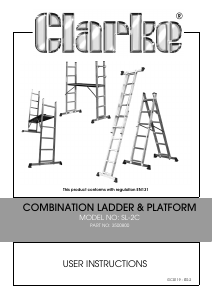
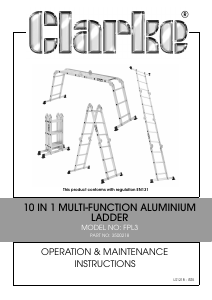

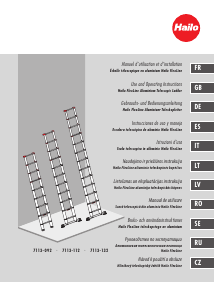
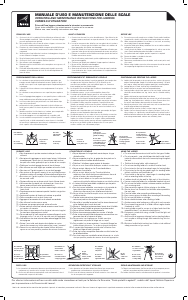
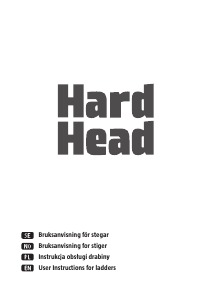
Praat mee over dit product
Laat hier weten wat jij vindt van de Draper FGL3A Ladder. Als je een vraag hebt, lees dan eerst zorgvuldig de handleiding door. Een handleiding aanvragen kan via ons contactformulier.